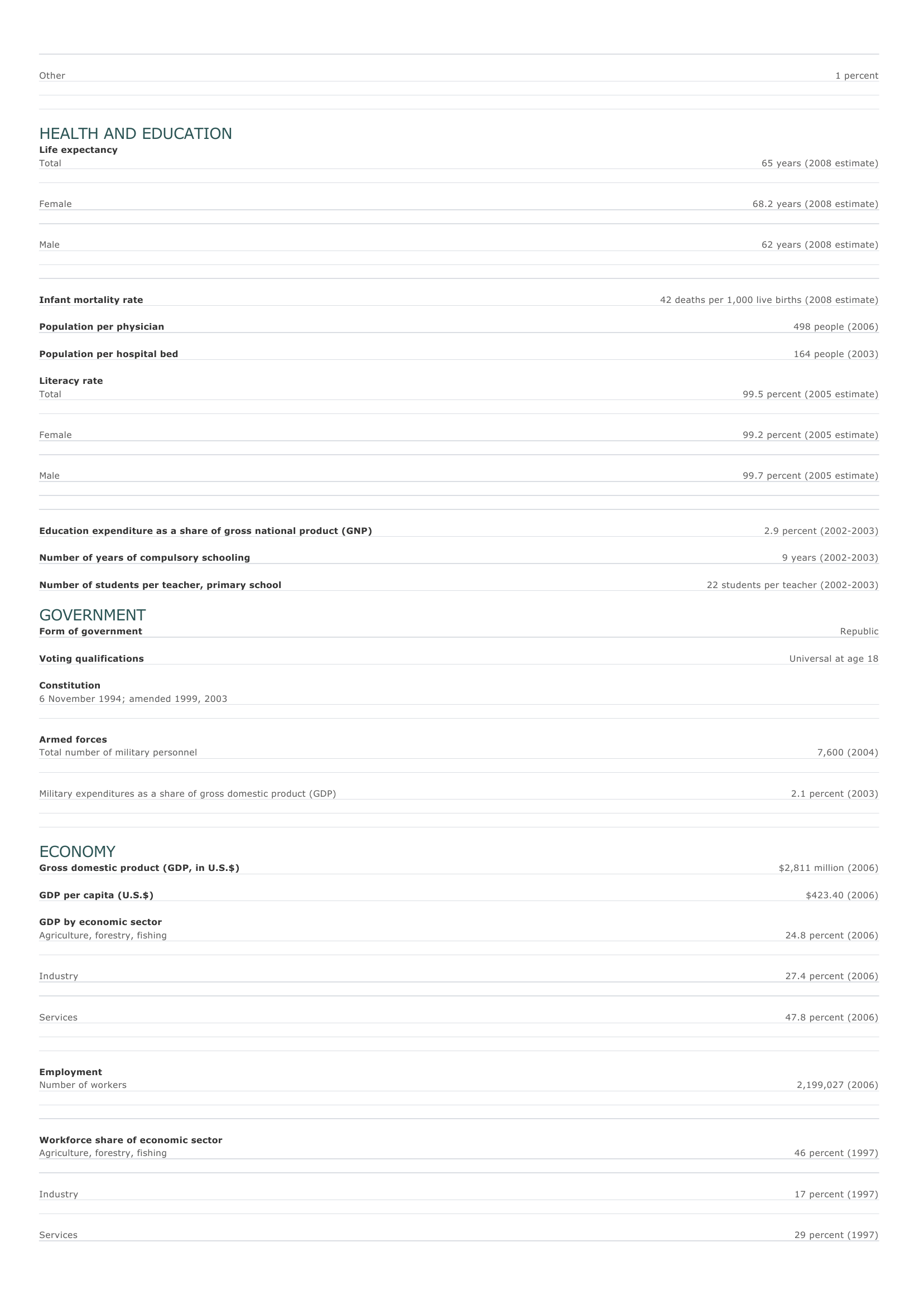Tajikistan Facts and Figures. BASIC FACTS Official name Capital Area Republic of Tajikistan Dushanbe 143,100 sq km 55,250 sq mi PEOPLE Population 7,211,884 (2008 estimate) Population growth Population growth rate 1.89 percent (2008 estimate) Projected population in 2025 9,510,130 (2025 estimate) Projected population in 2050 12,132,365 (2050 estimate) Population density 51 persons per sq km (2008 estimate) 131 persons per sq mi (2008 estimate) Urban/rural distribution Share urban 24 percent (2003 estimate) Share rural 76 percent (2003 estimate) Largest cities, with population Dushanbe 554,000 (2003 estimate) K hujand 147,400 (2002 estimate) K ?lob 79,500 (2002 estimate) Q ?rghonteppa 61,200 (2002 estimate) ?roteppa 51,700 (2002 estimate) Ethnic groups Tajik 65 percent Uzbek 25 percent Russian 3 percent Tatar, Ukrainian, German, Kyrgyz, Jewish, Armenian 7 percent Languages Tajik (official), Dari, Russian, Uzbek Religious affiliations Sunni Muslim 80 percent Shia Muslim 4 percent Atheist 2 percent Orthodox (Russian) Christian 1 percent Nonreligious 12 percent O ther 1 percent HEALTH AND EDUCATION Life expectancy Total Female Male Infant mortality rate 65 years (2008 estimate) 68.2 years (2008 estimate) 62 years (2008 estimate) 42 deaths per 1,000 live births (2008 estimate) Population per physician 498 people (2006) Population per hospital bed 164 people (2003) Literacy rate Total 99.5 percent (2005 estimate) Female 99.2 percent (2005 estimate) Male 99.7 percent (2005 estimate) Education expenditure as a share of gross national product (GNP) Number of years of compulsory schooling Number of students per teacher, primary school 2.9 percent (2002-2003) 9 years (2002-2003) 22 students per teacher (2002-2003) GOVERNMENT Form of government Republic Voting qualifications Universal at age 18 Constitution 6 November 1994; amended 1999, 2003 Armed forces Total number of military personnel Military expenditures as a share of gross domestic product (GDP) 7,600 (2004) 2.1 percent (2003) ECONOMY Gross domestic product (GDP, in U.S.$) GDP per capita (U.S.$) $2,811 million (2006) $423.40 (2006) GDP by economic sector Agriculture, forestry, fishing 24.8 percent (2006) I ndustry 27.4 percent (2006) Services 47.8 percent (2006) Employment Number of workers 2,199,027 (2006) Workforce share of economic sector Agriculture, forestry, fishing 46 percent (1997) I ndustry 17 percent (1997) Services 29 percent (1997) Unemployment rate 2.7 percent (1997) National budget (U.S.$) Total revenue $285.4 million (2004) Total expenditure $279.3 million (2004) Monetary unit 1 Tajik ruble (TJR), consisting of 100 tanga Major trade partners for exports Netherlands, Russia, Uzbekistan, Turkey, and Switzerland Major trade partners for imports Uzbekistan, Russia, Kazakhstan, Ukraine, and Turkmenistan ENERGY, COMMUNICATIONS, AND TRANSPORTATION Electricity production Electricity from thermal sources Electricity from hydroelectric sources 2.32 percent (2003 estimate) 97.68 percent (2003 estimate) Electricity from nuclear sources 0 percent (2003 estimate) Electricity from geothermal, solar, and wind sources 0 percent (2003 estimate) Number of radios per 1,000 people 143 (1997) Number of telephones per 1,000 people 39 (2003) Number of televisions per 1,000 people 323 (2000 estimate) Number of Internet hosts per 10,000 people 0.11 (2003) Daily newspaper circulation per 1,000 people 20 (1996) Number of motor vehicles per 1,000 people 1.5 (1997) Paved road as a share of total roads 83 percent (1999) SOURCES Basic Facts and People sections Area data are from the statistical bureaus of individual countries. Population, population growth rate, and population projections are from the United States Census Bureau, International Programs Center, International Data Base (IDB) (www.census.gov). Urban and rural population data are from the Food and Agriculture Organization (FAO) of the United Nations (UN), FAOSTAT database (www.fao.org). Largest cities population data and political divisions data are from the statistical bureaus of individual countries. Ethnic divisions and religion data are largely from the latest Central Intelligence Agency (CIA) World Factbook and from various country censuses and reports. Language data are largely from the Ethnologue, Languages of the World, Summer Institute of Linguistics International (www.sil.org). Health and Education section Life expectancy and infant mortality data are from the United States Census Bureau, International Programs Center, International database (IDB) (www.census.gov). Population per physician and population per hospital bed data are from the World Health Organization (WHO) (www.who.int). Education data are from the United Nations Educational, Scientific and Cultural Organization (UNESCO) database (www.unesco.org). Government section Government, independence, legislature, constitution, highest court, and voting qualifications data are largely from various government Web sites, the latest Europa World Yearbook, and the latest Central Intelligence Agency (CIA) World Factbook. The armed forces data is from Military Balance. Economy section Gross domestic product (GDP), GDP per capita, GDP by economic sectors, employment, and national budget data are from the World Bank database (www.worldbank.org). Monetary unit, agriculture, mining, manufacturing, exports, imports, and major trade partner information is from the statistical bureaus of individual countries, latest Europa World Yearbook, and various United Nations and International Monetary Fund (IMF) publications. Energy, Communication, and Transportation section Electricity information is from the Energy Information Administration (EIA) database (www.eia.doe.gov). Radio, telephone, television, and newspaper information is from the United Nations Educational, Scientific and Cultural Organization (UNESCO) database (www.unesco.org). Internet hosts, motor vehicles, and road data are from the World Bank database (www.worldbank.org). Note Figures may not total 100 percent due to rounding. Microsoft ® Encarta ® 2009. © 1993-2008 Microsoft Corporation. All rights reserved.













